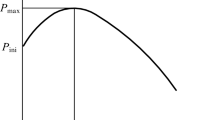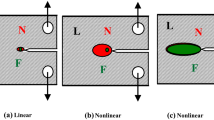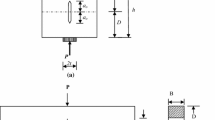Abstract
Comparative study for determining the K R -curves associated with the cohesive stress distribution for complete fracture process for two standard specimen geometries i.e., three-point bending test and compact tension test specimen geometries of concrete using analytical method and weight function approach is reported in the paper. The laboratory size specimen (100 ≤ D ≤ 400 mm) with initial-notch length/depth ratios 0.3 and 0.5 are considered in the investigation. The load-crack opening displacement curves for these specimens are obtained using well known version of Fictitious Crack Model (FCM). It is found from the numerical results that the weight function method improves computational efficiency without any appreciable error. The stability analysis on the K R -curves and the influence of specimen geometry and the size-effect on the K R -curves, the CTOD-curves and the process zone length during crack propagation of complete fracture process are also described.
Similar content being viewed by others
Abbreviations
- CT:
-
Compact tension
- TPBT:
-
Three-point bending test
- SIF:
-
Stress intensity factor
- DKFM:
-
Double-K fracture model
- CMOD:
-
Crack mouth opening displacement
- COD:
-
Crack opening displacement
- CTOD:
-
Crack tip opening displacement
- CTOD c :
-
Critical value of crack tip opening displacement
- LEFM:
-
Linear elastic fracture mechanics
- FCM:
-
Fictitious crack model
- CCM:
-
Cohesive crack model
References
ASTM International Standard E399-06 (2006) Standard test method for linear-elastic method plane-strain fracture toughness K IC of metallic materials
Bažant ZP, Oh BH (1983) Crack band theory for fracture of concrete. Mater Struct 16(93): 155–177
Bueckner HF (1970) A novel principle for the computation of stress intensity factors. Z Angew Math Mech 50: 529– 546
Carpinteri A (1989) Decrease of apparent tensile and bending strength with specimen size: two different explanations based on fracture mechanics. Int J Solid Struct 25: 407– 429
CEB-Comite Euro-International du Beton-CEB-FIP Model Code (1990) Bulletin D’Information, EPF Lausanne
Glinka G, Shen G (1991) Universal features of weight functions for cracks in Mode I. Eng Fract Mech 40(6): 1135–1146
Hillerborg A, Modeer M, Petersson PE (1976) Analysis of crack formation and crack growth in concrete by means of fracture mechanics and finite elements. Cem Concr Res 6: 773–782
Irwin GR (1960) Crack extension force for a part-through crack in a plate. ASTM Bull 243:29–40
Jenq YS, Shah SP (1985) Two parameter fracture model for concrete. J Eng Mech ASCE 111(10): 1227–1241
Karihaloo BL, Nallathambi P (1991) Notched beam test: mode I fracture toughness. In: Shah SP, Carpinteri A (eds) Fracture mechanics test methods for concrete. Report of RILEM Technical Committee 89-FMT. Chamman & Hall, London, pp 1–86
Krafft JM, Sullivan AM, Boyle RW (1961) Effect of dimensions on fast fracture instability of notched sheets. In: Proceedings of the crack propagation symposium, College of Aeronautics, Cranfield, England vol 1, pp 8–26
Kumar S, Barai SV (2008a) Determining the double-K fracture parameters for three-point bending notched concrete beams using weight function. Theor Appl Fract Mech (under submission)
Kumar S, Barai SV (2008b) determining double-K fracture parameters of concrete for compact tension and wedge splitting tests using weight function. Eng Fract Mech (under review)
Kumar S, Barai SV (2008c) Influence of specimen geometry on determination of double-K fracture parameters of concrete: a comparative study. Int J Fract 149:47–66
Kumar S, Barai SV (2008d) Weight function approach for determining crack extension resistance based on the cohesive stress distribution in concrete. Eng Fract Mech (under review)
Kumar S, Barai SV (2008e) Size-effect prediction from the double-K fracture model for notched concrete beam. Int J Damage Mech (accepted)
MATLAB, Version 7, The Math Works, Inc., Copyright 1984–2004
Murakami Y (1987) Stress intensity factors handbook vol-1. Pergamon, Oxford (Committee on Fracture Mechanics, The Society of Materials Science, Japan)
Petersson PE (1981) Crack growth and development of fracture zone in plain concrete and similar materials, Report No. TVBM-100, Lund Institute of Technology
Planas J, Elices M (1990) Fracture criteria for concrete: mathematical approximations and experimental validation. Eng Fract Mech 35: 87–94
Planas J, Elices M (1991) Nonlinear fracture of cohesive material. Int J Fract 51: 139–157
Reinhardt HW, Xu S (1999) Crack extension resistance based on the cohesive force in concrete. Eng Fract Mech 64: 563–587
Reinhardt HW, Cornelissen HAW, Hordijk DA (1986) Tensile tests and failure analysis of concrete. J Struct Eng ASCE 112(11): 2462–2477
Rice JR (1972) Some remarks on elastic crack-tip stress fields. Int J Solid Struct 8: 751–758
RILEM Draft recommendation 50-F (1985) Determination of the fracture energy of mortar and concrete by means of three-point bend test on notched beams. Mater Struct 18:285–290
RILEM Technical Committee 89-FMT (1990) Determination of fracture parameters (Ks IC and CT ODc) of plain concrete using three-point bend tests, proposed draft recommendation. RILEM, Mater Struct 23(138):457–460
Roesler J, Paulino GH, Park K, Gaedicke C (2007) Concrete fracture prediction using bilinear softening. Cem Concr Compos 29: 300–312
Tada H, Paris PC, Irwin G (1985) The stress analysis of cracks handbook. Paris Productions Incorporated, St. Louis
Xu S, Reinhardt HW (1998) Crack extension resistance and fracture properties of quasi-brittle materials like concrete based on the complete process of fracture. Int J Fract 92: 71–99
Xu S, Reinhardt HW (1999a) Determination of double-K criterion for crack propagation in quasi-brittle materials, Part I: experimental investigation of crack propagation. Int J Fract 98:111–149. doi:10.1023/A:1018668929989
Xu S, Reinhardt HW (1999b) Determination of double-K criterion for crack propagation in quasi-brittle materials, part II: analytical evaluating and practical measuring methods for three-point bending notched beams. Int J Fract 98: 151–177
Xu S, Reinhardt HW (1999c) Determination of double-K criterion for crack propagation in quasi-brittle materials, part III: compact tension specimens and wedge splitting specimens. Int J Fract 98: 179–193
Author information
Authors and Affiliations
Corresponding author
Rights and permissions
About this article
Cite this article
Kumar, S., Barai, S.V. Influence of specimen geometry and size-effect on the K R -curve based on the cohesive stress in concrete. Int J Fract 152, 127–148 (2008). https://doi.org/10.1007/s10704-008-9275-6
Received:
Accepted:
Published:
Issue Date:
DOI: https://doi.org/10.1007/s10704-008-9275-6




